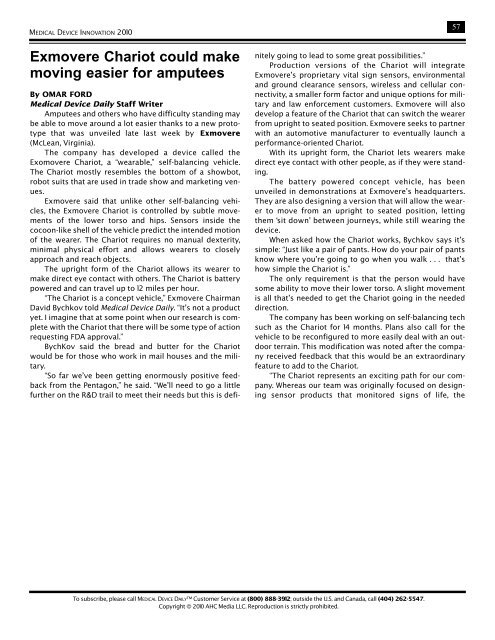MEDICAL DEVICE INNOVATION - Medical Device Daily
MEDICAL DEVICE INNOVATION - Medical Device Daily
MEDICAL DEVICE INNOVATION - Medical Device Daily
Create successful ePaper yourself
Turn your PDF publications into a flip-book with our unique Google optimized e-Paper software.
<strong>MEDICAL</strong> <strong>DEVICE</strong> <strong>INNOVATION</strong> 2010<br />
Exmovere Chariot could make<br />
moving easier for amputees<br />
By OMAR FORD<br />
<strong>Medical</strong> <strong>Device</strong> <strong>Daily</strong> Staff Writer<br />
Amputees and others who have difficulty standing may<br />
be able to move around a lot easier thanks to a new prototype<br />
that was unveiled late last week by Exmovere<br />
(McLean, Virginia).<br />
The company has developed a device called the<br />
Exomovere Chariot, a “wearable,” self-balancing vehicle.<br />
The Chariot mostly resembles the bottom of a showbot,<br />
robot suits that are used in trade show and marketing venues.<br />
Exmovere said that unlike other self-balancing vehicles,<br />
the Exmovere Chariot is controlled by subtle movements<br />
of the lower torso and hips. Sensors inside the<br />
cocoon-like shell of the vehicle predict the intended motion<br />
of the wearer. The Chariot requires no manual dexterity,<br />
minimal physical effort and allows wearers to closely<br />
approach and reach objects.<br />
The upright form of the Chariot allows its wearer to<br />
make direct eye contact with others. The Chariot is battery<br />
powered and can travel up to 12 miles per hour.<br />
“The Chariot is a concept vehicle,” Exmovere Chairman<br />
David Bychkov told <strong>Medical</strong> <strong>Device</strong> <strong>Daily</strong>. “It’s not a product<br />
yet. I imagine that at some point when our research is complete<br />
with the Chariot that there will be some type of action<br />
requesting FDA approval.”<br />
BychKov said the bread and butter for the Chariot<br />
would be for those who work in mail houses and the military.<br />
“So far we’ve been getting enormously positive feedback<br />
from the Pentagon,” he said. “We’ll need to go a little<br />
further on the R&D trail to meet their needs but this is definitely<br />
going to lead to some great possibilities.”<br />
Production versions of the Chariot will integrate<br />
Exmovere’s proprietary vital sign sensors, environmental<br />
and ground clearance sensors, wireless and cellular connectivity,<br />
a smaller form factor and unique options for military<br />
and law enforcement customers. Exmovere will also<br />
develop a feature of the Chariot that can switch the wearer<br />
from upright to seated position. Exmovere seeks to partner<br />
with an automotive manufacturer to eventually launch a<br />
performance-oriented Chariot.<br />
With its upright form, the Chariot lets wearers make<br />
direct eye contact with other people, as if they were standing.<br />
The battery powered concept vehicle, has been<br />
unveiled in demonstrations at Exmovere’s headquarters.<br />
They are also designing a version that will allow the wearer<br />
to move from an upright to seated position, letting<br />
them ‘sit down’ between journeys, while still wearing the<br />
device.<br />
When asked how the Chariot works, Bychkov says it’s<br />
simple: “Just like a pair of pants. How do your pair of pants<br />
know where you’re going to go when you walk . . . that’s<br />
how simple the Chariot is.”<br />
The only requirement is that the person would have<br />
some ability to move their lower torso. A slight movement<br />
is all that’s needed to get the Chariot going in the needed<br />
direction.<br />
The company has been working on self-balancing tech<br />
such as the Chariot for 14 months. Plans also call for the<br />
vehicle to be reconfigured to more easily deal with an outdoor<br />
terrain. This modification was noted after the company<br />
received feedback that this would be an extraordinary<br />
feature to add to the Chariot.<br />
“The Chariot represents an exciting path for our company.<br />
Whereas our team was originally focused on designing<br />
sensor products that monitored signs of life, the<br />
57<br />
To subscribe, please call <strong>MEDICAL</strong> <strong>DEVICE</strong> DAILY Customer Service at (800) 888-3912; outside the U.S. and Canada, call (404) 262-5547.<br />
Copyright © 2010 AHC Media LLC. Reproduction is strictly prohibited.
















